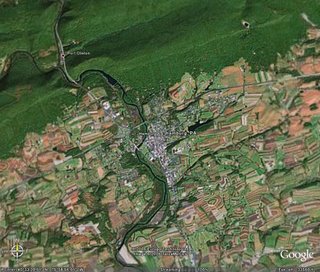
I began the day by driving some more in a northerly direction. The terrain was distinctly more mountainous and less populated. There were mile long stretches without any signs of human habitation. But then again, mountains are inherently difficult to inhabit on a permanent basis. The rains of the night before had dissapated and everything had the appearance of profound beauty. There was no hurry in my driving since I wasn't going anywhere in particular. My car passed by some state game lands. I got out and turned hunter/gatherer with the longbow. After a few hours of wandering in the woods, I chanced upon some wild slowberries which I collected, washed with some spring water and gobbled down.
A short while after that, I spotted a woodchuck just sitting there staring at the sky. I let loose one of my arrows from 35 yards away....and MISSED!!! My horribly inaccurate arrow flew into a bush a several feet away and the woodchuck fled in the opposite direction. I went back to the car and drove on.

Several hours more of driving took me to a bend in the road that presented a magnificent, panoramic view of the valley below. There was a post by the road, and it mentioned that this road used to be part of an old Native American trail network. About 400 years ago, a tribe called the Huron inhabited the land that I drove upon. The Huron fought the English and French colonists who tried to subjugate them, they also fought other Indian tribes. That trail over the mountain side was part of a strategic defense over that piece of their territory. Needless to say, the stone-age Huron had no real chance against the European colonists. The French introduced diseases such as smallpox which wiped out large swathes of their population and the English gave their greatest tribal rival, the Iroquis, muskets and cannons. The Huron had nothing more than primitive bows and wooden hatchets. Huron flint and obsidian couldn't defeat European steel, and arrows were no match against gunpowder. And thus the Huron were massacred by their Iroquis enemies. All that remains of their legacy is this little road and a few dusty books in forgotten libaries.
 I began heading back home around mid-day. After several hours of driving, I came upon the small town of Hamburg. Right outside the town, there was a huge Hunting Outfitter store called Cabela's. It was massive, truely gargantuan, the size of a large mall. I suppose this one store must be responsible for the bulk of the Town's employment opportunities. I went into this shrine of the Outdoors and browsed their archery section. The dismal performance of my home-made bow and arrows is an embarrassment that needs to be rectified. A very friendly old gentleman by the name Elliot was of great help in that Store. We spent an hour chatting about the primitive bows of North America and that of traditional wooden arrow construction. Elliot was formerly a machinist at an industrial plant near Reading. After the Industrial Revolution passed the region by, the only employment he could find was to become an arrowsmith at Cabela's. Making a long story short, I ended up buying half a dozen razor sharp carbon steel arrowheads that perfectly matched with my quiver of wooden arrows.
I began heading back home around mid-day. After several hours of driving, I came upon the small town of Hamburg. Right outside the town, there was a huge Hunting Outfitter store called Cabela's. It was massive, truely gargantuan, the size of a large mall. I suppose this one store must be responsible for the bulk of the Town's employment opportunities. I went into this shrine of the Outdoors and browsed their archery section. The dismal performance of my home-made bow and arrows is an embarrassment that needs to be rectified. A very friendly old gentleman by the name Elliot was of great help in that Store. We spent an hour chatting about the primitive bows of North America and that of traditional wooden arrow construction. Elliot was formerly a machinist at an industrial plant near Reading. After the Industrial Revolution passed the region by, the only employment he could find was to become an arrowsmith at Cabela's. Making a long story short, I ended up buying half a dozen razor sharp carbon steel arrowheads that perfectly matched with my quiver of wooden arrows.The rest of my journey was fairly uneventful. I reached home late saturday night along Route 61 South.
No comments:
Post a Comment